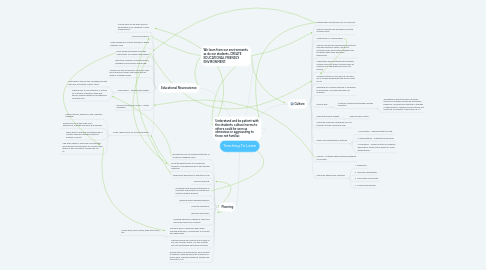
1. Educational Neuroscience
1.1. Critical parts of the brain are still developing in our students (Young Adolescence)
1.2. "Survive and thrive"
1.3. Lived experiences impact the way in which students learn.
1.4. Brain works best when it has the opportunity to connect with others.
1.5. Retention requires constant practice, engaging conversation and review.
1.6. Students as well as teachers must put aside preconceived notions and biases that lie deep in untapped areas.
1.7. "Lizard Brain" - internal gate keeper
1.7.1. Lizard Brain ruled by the Amygdala and the Reticular Activating System (RAS)
1.7.2. Getting RAS to pay attention is critical for culturally responsive teaching, directs learners attention at beginning of task/lesson.
1.8. Physical structures in brain = Brains Hardware
1.9. Limbic region home to "emotional brain"
1.9.1. Links emotions, behaviors, and cognition together.
1.9.2. Primary role is to help learn from experience, manage emotions & remember.
1.9.3. When brain is learning something new it clusters neurons together (assists in problem solving).
1.9.4. "The Brain seeks to minimize social threats and maximize opportunities to connect with others in the community (Hammond Ch. 3)."
2. Planning
2.1. Introduction key to grasping attention of students, engaging early!
2.2. Essential question key to connecting students' lived experiences to educational materials.
2.3. Technology huge part of education now.
2.4. Concept learning.
2.5. Create and use different strategies of formative assessments to gauge and monitor student learning.
2.6. Planning should engage students.
2.7. Essential Questions.
2.8. Learning Objectives.
2.9. Planning should be created in steps and should be relative to students.
2.10. Students learn in different ways when working with peers, opportunity to connect and share ideas.
2.10.1. Group work, peer review, think-pair-share, etc.
2.11. Planning should be creative and outside of our own comfort zones, our own interest can not overshadow necessary materials.
2.12. Efficient ways of learning vary from student to student, planning should be a mixture of group work, individual research, teacher led instruction, etc.
3. We learn from our environments, as do our students, CREATE EDUCATIONAL FRIENDLY ENVIRONMENT.
4. Understand and be patient with the students, cultural norms to others could be seen as obnoxious or aggravating to those not familiar.
5. Culture
5.1. Relationships dictate success in classroom
5.2. Culture impacts how we teach, and how students learn.
5.3. Collectivism vs. Individualism
5.4. Culture can also be represented effectively through classroom setup. The more culturally open and trusting students feel, the better they learn and apply themselves.
5.5. Understand and be patient with students, cultural norms to others could be seen as obnoxious or aggravating to those not familiar.
5.6. Multiple cultures in one room at one time, key is finding techniques that are inclusive for all.
5.7. Widening our cultural aperture is necessary to effectively communicate with our students.
5.8. Implicit Bias
5.8.1. Culturally responsive teaching requires relfection
5.8.1.1. "Engaging in reflection helps culturally responsive teachers recognize the beliefs, behaviors, and practices that get in the way of their ability to respond constructively and positively to students (Hammond Ch. 4)."
5.9. Make the familiar strange
5.9.1. Examine own culture
5.10. Culturally responsive teaching calls for teachers to take "emotional risk."
5.11. Widen our interpretation aperture
5.11.1. 1. Description - Describe what you see
5.11.2. 2. Interpretation - Interpret the situation
5.11.3. 3. Evaluation - Assign positive or negative significance to the action based on initial interpretation.
5.12. Culture = software that programs hardware in the brain.
5.13. Culturally Responsive Teaching
5.13.1. 1. Awareness
5.13.2. 2. Learning Partnerships
5.13.3. 3. Information Processing
5.13.4. 4. Community Building

